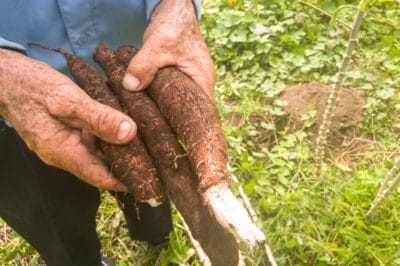About Cassava
The cassava plant is related to spurge, and like that plant it contains some toxins that must be neutralized before eating. The shrub may grow to nine feet in height and roots may be three or four inches in diameter. The plant is used in a variety of foods and is also the source of tapioca. It prefers a hot, humid climate such as that found in Florida.
Cassava Varieties
Many cassava varieties are known only by numbers because they are primarily grown commercially. In selecting a variety, you should look for the following:
- High dry matter – 30 percent or more.
- High level of mealiness – this translates to a sweeter flavor.
- Varieties that bulk early, which means more food per root.
- Varieties that are tolerant of weeds, pests and diseases.
Growing Cassava
Cassava plants like sandy clay loams. Add limestone to acid soils, as cassava will not produce good roots in soils that are too acid. The soil should be well-drained. Humus, like well-rotted leaf mold, should be worked into the soil three or four months before planting. You can plant as early as March or April. The plant produces better with ample water, but can tolerate drought.
Preparing the Cuttings
Cassava is propagated with root cuttings. Choose roots (the cuttings are called setts) from healthy, disease-free, vigorously growing plants at least eight months old. Cut root segments into pieces three to nine inches long. Longer roots typically do better. Cut setts from the middle portion of the root. Make sure each section has at least three or four nodes.
Disease Prevention
Choosing healthy plants is half the battle, but you can also prevent disease with management practices. Sterilize your knife or saw in a one percent bleach solution before and between cutting the setts. Commercial growers bundle the setts together and dip in a fungicide/insecticide solution for 10 minutes and let them drain before planting. Healthy plants in an organic garden don’t usually need this treatment.
Planting the Setts
Cassava setts are usually planted on ridges about eight or nine inches high and three feet apart. Plant the sett so at least three inches of the root is below the ground. The sett should be placed in the ground at about a 45 degree angle, with two or three nodes above the surface.
